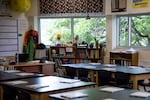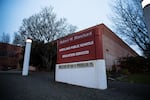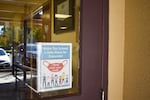Two of Oregon’s largest districts are making plans to return students to class, including older students, over the next two months.
In meetings this week with the teachers union and the school board, Portland Public Schools offered complicated plans for how the state’s largest district might start hybrid learning for middle and high school students, by the beginning of the fourth quarter. The Beaverton School District has made a similar commitment to restart in-person by April 19, but it hasn’t offered details on those plans.
“While we do have a detailed plan, it’s not something that I can share at this time,” said Beaverton public communications officer Shellie Bailey-Shah in an email to OPB, citing “negotiations with our employee unions regarding working conditions.” Bailey-Shah said that plans have been shared with the Beaverton Education Association as well as the Oregon School Employees Association, and the district expects to share plans more widely next week.

Under plans under discussion at Portland Public Schools, classrooms like this one at Harriett Tubman Middle School could reopen for students as soon as April.
Rob Manning / OPB
PPS started sharing initial plans at meetings over the last week with school board members and teachers. The state’s largest district is proposing a hybrid learning approach, which blends a few hours of in-person instruction a few days a week, with a continuation of some distance learning. While Beaverton hasn’t offered a detailed plan, like PPS, it has suggested using technology to provide “simultaneous” instruction to in-person students, as well as those continuing to learn at home.
PPS outlines hybrid options
While returning elementary students to classrooms during a global pandemic is no simple task, the number of students and the structure of classes in secondary schools make reopening classrooms for older students an even more challenging prospect.

Portland Public Schools district headquarters, Portland, Ore., Dec. 15, 2018.
Bradley W. Parks / OPB
“Obviously, our high schools have some challenges and limitations, some of them are 1600 kids,” acknowledged PPS chief of schools Shawn Bird at a meeting over Zoom this week with the Portland Association of Teachers.
Bird outlined two main options for high schools — one would offer high school students two hour-long classes on alternating days at school; the other would offer a single hour-and-a-half long class on those alternating, in-person school days.
The two options have strengths and weaknesses, as Bird explained. For instance, while the single-class option would offer less in-person instruction and more independent work, it would offer greater flexibility for school administrators and might align better for students continuing to work entirely from home.
Bird also rolled out hybrid options for middle schools, which would divide schools into three cohorts, with students in those cohorts attending a full day of school in-person, from 9:15 until 3:45 on the days they go to school. Under one option, students would attend on alternating days; under another, they would alternate weeks.
‘Simulcast’ instruction suggested for students in-person and at-home
In the middle school options, when students were not attending in-person, they would continue to receive instruction through a “simulcast” of what’s happening in the classroom. This “simulcast” approach is also potentially part of the approach for high school instruction. But requiring teachers to provide instruction directly to students physically in classrooms at the same time they’re keeping students engaged by remote has been met with skepticism by Portland teachers.
“I think that the limitations of doing simulcast — remote and in-person teaching at the same time — is going to present a lot of limitations to education and learning,” said Portland teacher Emily Markowitz in the PAT-PPS meeting on Feb. 18, when the district discussed simultaneous instruction as an approach for elementary schools.
In presenting to the PPS school board this week, Bird suggested that simulcast is in place already in nearby school districts.
“People have asked, ‘who else does this?’ We have some neighbors who do it, as close as Beaverton and West Linn-Wilsonville for secondary schools,” Bird said, after showing a video from Fairfax, Va., of students learning in a simulcast model.
But the two districts that Bird cited appear to be new to the technology as well. Bailey-Shah in Beaverton clarified that her district is not using a simulcast approach right now. It’s in the same boat as Portland — planning on it.
“We do not currently do this. It’s our plan to do it at the secondary level, starting April 19,” Bailey-Shah wrote in an email to OPB. The communications director at West Linn-Wilsonville, Andrew Kilstrom said that his district has practiced using the technology with a limited number of students, but hadn’t started using the technology with any cohort of students until Wednesday, when kindergarten classes tried it for the first time.
“We have not used it with secondary students as they are still in Comprehensive Distance Learning at home,” Kilstrom said in an email to OPB.
While Beaverton hasn’t shared the level of detail that PPS has, BSD administrators have made clear they’re planning to have teachers instruct students in-person and by remote at the same time.
“Simply put, teachers would provide live instruction from school to all students. Students who prefer to stay in Comprehensive Distance Learning (CDL) would receive that live instruction via their computers at home,” according to an FAQ section of the Beaverton School District’s web page. “Students who opt for Hybrid would be divided into two attendance groups. They’d spend two full days on campus and three days online at home, as current state-mandated safety protocols do not allow for all students to be on campus at the same time.”
PPS feeling urgency to reopen
The pursuit of hybrid instruction comes in the context of many parents, as well as Gov. Kate Brown, pushing for schools to open quickly, with COVID-19 case numbers declining and distance learning leading to difficulties, such as deteriorating student mental health, academic decline and poor student attendance and engagement. Teachers and some parents, however, have expressed caution about moving into school buildings too quickly, without well-structured plans and sufficient safety protocols in place.

A sign at Hillsboro Online Academy asks people entering the building to wear masks.
Elizabeth Miller / OPB
Both PPS and BSD are in labor negotiations with employee unions to reach an agreement about how to resume in-person instruction.
In this week’s PPS school board meeting, district officials emphasized the context for resuming hybrid learning — a decline in COVID-19 case numbers, and attendance in distance learning as a significant problem. The district provided numbers showing among Black students, the share of students missing at least one school day every other week has risen to 49.5%, and for Latino students, it’s risen to 44.2%.
“I think this is super concerning,” responded board member Julia Brim-Edwards.
As for “simulcast” as the right approach, PPS chief of schools Shawn Bird said that other approaches to hybrid are difficult to implement, especially for middle and high schools. He said it’s possible to limit class sizes and maintain health protections in some elementary schools, but at others, simulcasting can make it easier to meet all the important priorities, including keeping students with their same teachers. He said for older students, with large groups of students and teachers who are limited by their license in what they can teach, simulcasting is the most practical solution.
“This is not business as usual,” said Bird. “This is a pandemic and we need to respond in different ways.”
